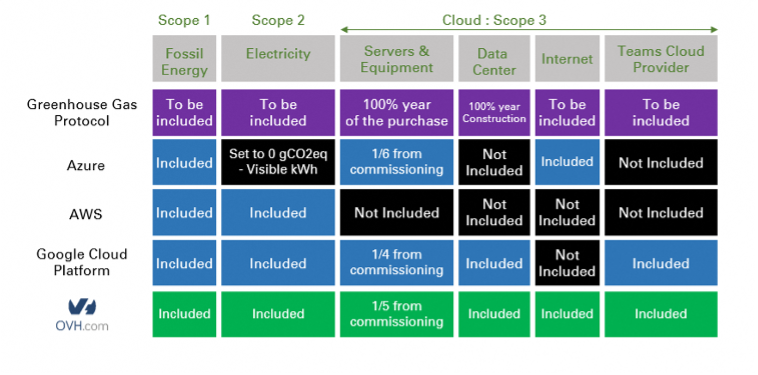GHG Protocol, CUE, Emissions Scope 1, 2, 3… You are still in there again! Trying to make sense of the carbon impact assessment for your cloud services? Making sure you have figured out what could be the best options to answer sustainability criteria by 2030 and run your business the sustainable way? Right, too bad for you, there is a deluge of metrics everywhere. But here is a sure-fire way to find your way around.
Tones of sustainability criteria are popping up in various public and non-public studies. Worse still, there’s no trace of the robust certifications, methodologies and organizations that would best suit you in building your golden path to the sustainable rainbow.
Simply because they are not unified, the methodologies are often unreliable, non-transparent or even biased.
But search no more. We have been through the whole process too, and we can help you make sense of the proven indicators you should turn to – and definitely use – for comparing best-in-class Cloud players on sustainability grounds.
Here is a list of them below. Our expertise combined with European standards are paramount certainty that we took the precautions to check their sincerity and identify any potential bias in their interpretation.
Global Indicators that answer the most demanding protocols:
- Carbon footprint as per the GHG protocol
This indicator is a standardized compatibility (comparable to IFRS in financial statements).
It states very clearly the sources of emission that must be considered, pointing out how organize them by categories (scopes). This allows a better reading of the levers that are directly managed by the company.
The most frequently observed bias is the absence of Scope 3 (indirect upstream and downstream emissions) or its incomplete nature. However, this is a significant part of the cloud impact mostly driven by the server manufacturing process.
For example, in 2023, OVHcloud Scope 3 accounted for 54.5% of our global emissions.
On Scope 2 (indirect emissions), which corresponds to the emissions related to the production of electricity used by the company, far too many players are reporting the matter by using “market based” emission factors and failing to do so with “location based” emission factors.
Truth is: unless the datacenter is self-producing/consuming 24/7 at site level, the nature of the electricity that powers the datacenter is that of the energy mix of the territory in which it is generated.
That’s why only location-based factors are relevant. Using market-based factors in addition is only interesting to demonstrate the effect of the renewable energy purchasing policy that the company has implemented via CPPAs (Corporate Power Purchase Agreements) or other Renewable Energy Certificates mechanisms.
In 2023, OVHcloud Scope 2 accounted for 44.7% of our global emissions, and the share of renewable energy in our energy mix was 91%.
It is easy to get a clearer picture by asking simple questions such as:
- Do you report your Scope 3?
- On what basis do you take into account the carbon weight of your IT equipment?
- What emission factors do you use for Scope 2?
- Do you include air conditioning, heating of the office premises?
- Travel, commuting, equipment supply for employees?
- CUE (Carbon Usage Effectiveness) as defined in ISO/IEC 30134-8:2022
One must take into account that the cloud industry is reluctant to publish it. Even though it allows Scopes 1 and 2 to be put into perspective on the size of the business and thus allows the players to compare with each other.
In 2023, OVHcloud CUE was 0.18 kgCO2/kWh (location based).
The advantage of this indicator is that, for a given energy mix, it makes it possible to compare the performance of two Cloud Services Providers on the energy efficiency of their infrastructure, since the lower the PUE (Power Usage Effectiveness), the lower Scope 2 will be (on a pro forma IT load basis).
- Overall emissions (Scopes 1, 2 and 3) over the workforce
These indicators can be derived easily from information contained in companies’ extra-financial performance statements (when published). Or, through information available in databases such as the Carbon Disclosure Project (CDP). It has to be considered with great caution when it is used. As everything depends on where the player operates in the value chain, as well as the completeness of its carbon accounting.
For example, components manufacturers will typically be between 50 and 100 TCO2e per employee per year, whereas cloud operators will be between 25 and 50 TCO2e per employee per year.
For your information, in 2023, OVHcloud overall emissions were at 131 kTCO2e for 2,900 employees, or 45 TCO2e per employee per year across the entire cloud value chain: from server manufacturing to IaaS/PaaS/SaaS services.
Indicators at cloud services level
By nature, they derive from the global indicators. They will only be relevant if the company’s overall carbon footprint is comprehensive and accurate in the first place.
- The carbon footprint of a given cloud service (IaaS, PaaS or SaaS)
You can find many carbon “calculators” on the market. Though the methodologies differ greatly, what matters is the ability of these calculators to accurately allocate Scope 2 and Scope 3, the highest chunks of the carbon emissions.
OVHcloud launched its calculator in 2023 for all of its Private Cloud services (Bare Metal, Hosted Private Cloud), and here are a few benchmarking elements to help you understand its benefits:

In 2024, we plan to extend this tool to the Public Cloud for full coverage of our range of cloud services. The comparison with the players will then be possible on all products segments.
As with the overall indicators, it is possible to see more clearly through simple questions such as:
o What are the emissions related to the manufacturing phase of IT infrastructure? Do you also reallocate a portion of the internal IT infrastructure required to deliver my services?
o What are the emissions related to the usage phase (electricity)? What factors do you take (market vs location based)? Do you take into account measured or theoretical power consumption? If you don’t measure it, which model do you use: maximum consumption, average consumption, etc?
o Do you also reallocate all other of your company’s emissions that are essential for the operations of the services (network, buildings, freight, travels, wastes, etc.)?
- The carbon footprint of a given cloud service (IaaS, PaaS or SaaS) divided by its price (economical intensity)
This indicator should not be used. Regardless of the fact that it is first necessary to ensure that the numerator of the ratio (absolute emissions) covers all emission sources, this indicator induces an undeniable bias: it places the least expensive actors with comparable emissions at a disadvantage.
Worse, for an equivalent service, a 20% less emitting and 30% cheaper player will have a lower “rating”!
- The carbon footprint of a given cloud service per physical or functional unit
This is definitely a good approach. By thinking in terms of functional units, any type of cloud service can be rebuilt, and its impact accurately calculated on a bottom-up approach.
For that sake, the redesign of the PCR (Product Category Rule) is currently in progress. OVHcloud is proud to have answered ADEME’s call to participate. The results are expected at the end of the year, and we will act as an echo chamber to spread them widely.
A temperature, a mass, a volume are indicators that are easy to compare because they are normalized. A financial statement also because it is standardized and audited before publication.
The same logic should guide the publication of environmental indicators.
If the “producer” doesn’t do it, the “consumer” should.
Find out more about our environmental commitments

